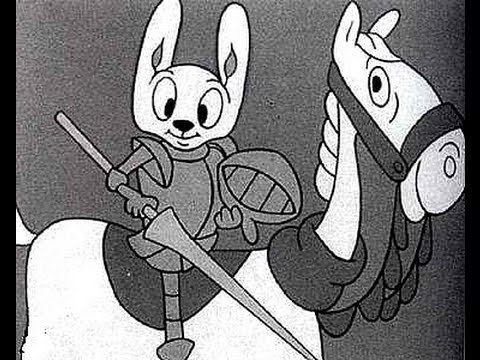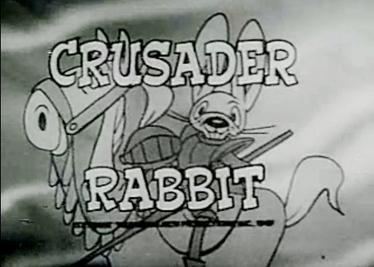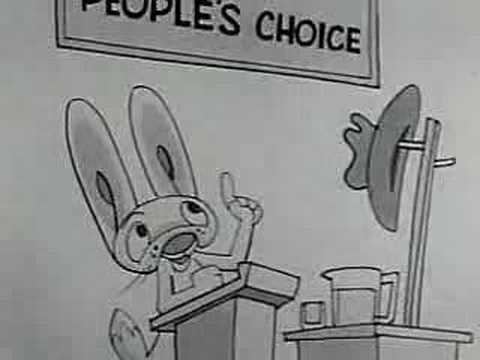6.4 /10 1 Votes6.4
6.3/10 TV Original language(s) English First episode date 1 September 1950 Number of seasons 3 | 6.4/10 IMDb Country of origin United States No. of seasons 3 Final episode date 1 December 1959 | |||||||||||||||||||||||||||||||||
 | ||||||||||||||||||||||||||||||||||
Created by Alexander AndersonJay Ward Starring First series:Lucille BlissSecond series:Ge Ge PearsonRuss CoughlanBoth series:Vern LoudenRoy Whaley Opening theme "Rabbit Fanfare" (adapted from "The Trail To Mexico") & "Main Title Rabbit" (adapted from "Ten Little Indians") Networks Similar The Rocky and Bullwinkl, Hoppity Hooper, George of the Jungle, The Huckleberry Hound S, Tom Terrific | ||||||||||||||||||||||||||||||||||
Crusader rabbit crusade 1 episode 01
Crusader Rabbit is the first animated series produced specifically for television. Its main characters were Crusader Rabbit and his sidekick Ragland T. "Rags" Tiger, and their nemesises Dudley Nightshade and Bilious Green. The stories were 4-minute-long satirical cliffhangers.
Contents
- Crusader rabbit crusade 1 episode 01
- Production history
- Legacy
- In popular culture
- First series
- Episodes
- Production staff
- Voices
- Second series
- References

The concept was test marketed in 1948, while the initial episode – Crusader vs. the State of Texas – aired on KNBH (now KNBC) in Los Angeles on August 1, 1949. The program was syndicated from 1950 to 1952 for 195 episodes, then was revived in 1959 for 260 color episodes. Jay Ward, who went on to create The Rocky and Bullwinkle Show, was involved as business manager and producer.

Production history
The concept of an animated series made for television came from animator Alex Anderson, who worked for Terrytoons Studios. Terrytoons turned down Anderson's proposed series, preferring to remain in theatrical film animation. Consequently, Anderson approached Jay Ward to create a partnership – Anderson being in charge of production and Ward arranging financing. Ward became business manager and producer, joining with Anderson to form "Television Arts Productions" in 1947. They tried to sell the series – initially presented as part of a proposed series, The Comic Strips of Television, which featured an early incarnation of Dudley Do-Right – to the NBC television network, with Jerry Fairbanks as the network's "supervising producer". NBC did not telecast Crusader Rabbit on their network, but allowed Fairbanks to sell the series in national syndication, with many NBC affiliates, including those in New York and Los Angeles, picking it up for local showings. WNBC-TV in New York continued to show the original Crusader Rabbit episodes from 1950 through 1967, and some stations used the program as late as the 1970s.

The original series employed limited animation, appearing almost as narrated storyboards with frequent cuts and minor movement by the characters, much in the style of another early NBC "animation" program Tele-Comics. This was due to the limited budget that producers Jay Ward and Alex Anderson worked with to film the series. In 1948 Clarence E. Wheeler created the original opening and closing theme for the animated series, adapting and arranging the folk melodies The Trail to Mexico (known on cue sheets as "Rabbit Fanfare") and Ten Little Indians (known as "Main Title Rabbit").

Each program began with a title sequence of a mounted knight galloping across the screen. The episodes then featured a short, usually satirical, adventure in the form of a movie serial, ending with a cliffhanger.
Crusader Rabbit was syndicated from 1950 to 1952, totaling 195 episodes (divided into ten "crusades"), and then re-aired for many years. It featured Crusader Rabbit, his companion Ragland T. Tiger (Rags), and their occasional nemesis – Dudley Nightshade (called Ill-regard Beauregard in a few episodes), and his sidekick Bilious Green. Some episodes featured Crusader's and Rags's friends Garfield the Groundhog or Arson and Sterno, a two-headed dragon. Ragland Tiger's name came from the jazz tune "Tiger Rag" his middle initial "T" stands for The (as in Rags The Tiger), while Dudley Nightshade's name was a play on the poisonous plant, "deadly nightshade". As a running gag, another character would ask Rags what the "T" stood for, to which he'd reply, "Larry. My father couldn't spell!"
The series was revived and 13 new "crusades" (totaling 260 color episodes) were produced in 1956 by Shull Bonsall's Capital Enterprises. Bonsall purchased Television Arts Productions and gained the rights to Crusader Rabbit, during a protracted legal battle between Jay Ward, Alex Anderson, Jerry Fairbanks and the NBC network, over ownership of the series. Animation was provided by Bonsall's Creston Studios, also known as TV Spots, Inc., supervised by Bob Ganon and Gerald Ray. The new series was not seen until early 1959.
The revived (2nd) series used an opening and closing theme from the British "Impress" production music library licensed by Emil Ascher publishing of New York. It was titled "Juggins", and was composed by Van Phillips, the professional name of Alexander Van Cleve Phillips.
Lucille Bliss provided the voice of Crusader Rabbit in the original series; she was replaced by Ge Ge Pearson in the revived series. Vern Louden played Rags in both. Dudley Nightshade was voiced by Russ Coughlan, and narration was by Roy Whaley.
Legacy
The success of Crusader Rabbit inspired many more television cartoon character packages. Jay Ward would later produce The Rocky and Bullwinkle Show. In 1985, Rhino Entertainment released the first two volumes of Crusader Rabbit in a planned home-video release of all the original episodes. However, 20th Century Fox claimed the distribution rights by their acquisition of previous owner Metromedia Producers Corporation. No further video releases of Crusader Rabbit have been produced.
In popular culture
First series
The first series aired from 1950 to 1952 through syndication, with 195 episodes produced.
Episodes
Production staff
Voices
Second series
The second series premiered in 1956 syndication with 260 episodes produced, 20 "chapters" per episode. They were later edited into 13 one-hour programs.
